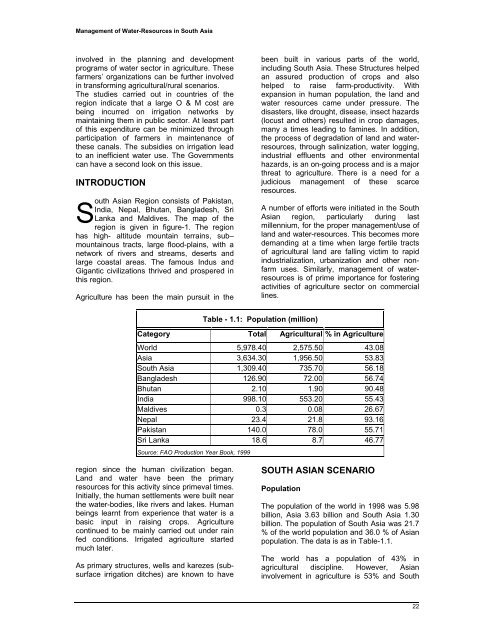Present Scenario and Future Prospects - Science Vision
Present Scenario and Future Prospects - Science Vision
Present Scenario and Future Prospects - Science Vision
You also want an ePaper? Increase the reach of your titles
YUMPU automatically turns print PDFs into web optimized ePapers that Google loves.
Management of Water-Resources in South Asia<br />
involved in the planning <strong>and</strong> development<br />
programs of water sector in agriculture. These<br />
farmers’ organizations can be further involved<br />
in transforming agricultural/rural scenarios.<br />
The studies carried out in countries of the<br />
region indicate that a large O & M cost are<br />
being incurred on irrigation networks by<br />
maintaining them in public sector. At least part<br />
of this expenditure can be minimized through<br />
participation of farmers in maintenance of<br />
these canals. The subsidies on irrigation lead<br />
to an inefficient water use. The Governments<br />
can have a second look on this issue.<br />
INTRODUCTION<br />
S<br />
outh Asian Region consists of Pakistan,<br />
India, Nepal, Bhutan, Bangladesh, Sri<br />
Lanka <strong>and</strong> Maldives. The map of the<br />
region is given in figure-1. The region<br />
has high- altitude mountain terrains, sub–<br />
mountainous tracts, large flood-plains, with a<br />
network of rivers <strong>and</strong> streams, deserts <strong>and</strong><br />
large coastal areas. The famous Indus <strong>and</strong><br />
Gigantic civilizations thrived <strong>and</strong> prospered in<br />
this region.<br />
Agriculture has been the main pursuit in the<br />
region since the human civilization began.<br />
L<strong>and</strong> <strong>and</strong> water have been the primary<br />
resources for this activity since primeval times.<br />
Initially, the human settlements were built near<br />
the water-bodies, like rivers <strong>and</strong> lakes. Human<br />
beings learnt from experience that water is a<br />
basic input in raising crops. Agriculture<br />
continued to be mainly carried out under rain<br />
fed conditions. Irrigated agriculture started<br />
much later.<br />
As primary structures, wells <strong>and</strong> karezes (subsurface<br />
irrigation ditches) are known to have<br />
been built in various parts of the world,<br />
including South Asia. These Structures helped<br />
an assured production of crops <strong>and</strong> also<br />
helped to raise farm-productivity. With<br />
expansion in human population, the l<strong>and</strong> <strong>and</strong><br />
water resources came under pressure. The<br />
disasters, like drought, disease, insect hazards<br />
(locust <strong>and</strong> others) resulted in crop damages,<br />
many a times leading to famines. In addition,<br />
the process of degradation of l<strong>and</strong> <strong>and</strong> waterresources,<br />
through salinization, water logging,<br />
industrial effluents <strong>and</strong> other environmental<br />
hazards, is an on-going process <strong>and</strong> is a major<br />
threat to agriculture. There is a need for a<br />
judicious management of these scarce<br />
resources.<br />
A number of efforts were initiated in the South<br />
Asian region, particularly during last<br />
millennium, for the proper management/use of<br />
l<strong>and</strong> <strong>and</strong> water-resources. This becomes more<br />
dem<strong>and</strong>ing at a time when large fertile tracts<br />
of agricultural l<strong>and</strong> are falling victim to rapid<br />
industrialization, urbanization <strong>and</strong> other nonfarm<br />
uses. Similarly, management of waterresources<br />
is of prime importance for fostering<br />
activities of agriculture sector on commercial<br />
lines.<br />
Table - 1.1: Population (million)<br />
Category Total Agricultural % in Agriculture<br />
World 5,978.40 2,575.50 43.08<br />
Asia 3,634.30 1,956.50 53.83<br />
South Asia 1,309.40 735.70 56.18<br />
Bangladesh 126.90 72.00 56.74<br />
Bhutan 2.10 1.90 90.48<br />
India 998.10 553.20 55.43<br />
Maldives 0.3 0.08 26.67<br />
Nepal 23.4 21.8 93.16<br />
Pakistan 140.0 78.0 55.71<br />
Sri Lanka 18.6 8.7 46.77<br />
Source: FAO Production Year Book, 1999<br />
SOUTH ASIAN SCENARIO<br />
Population<br />
The population of the world in 1998 was 5.98<br />
billion, Asia 3.63 billion <strong>and</strong> South Asia 1.30<br />
billion. The population of South Asia was 21.7<br />
% of the world population <strong>and</strong> 36.0 % of Asian<br />
population. The data is as in Table-1.1.<br />
The world has a population of 43% in<br />
agricultural discipline. However, Asian<br />
involvement in agriculture is 53% <strong>and</strong> South<br />
22


